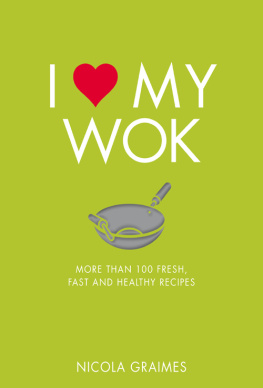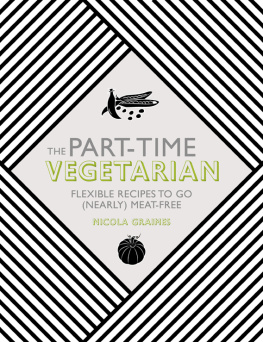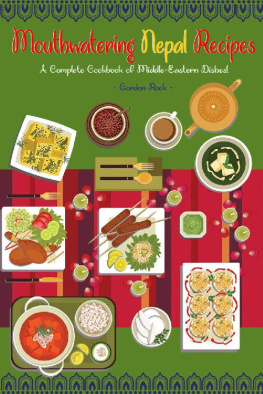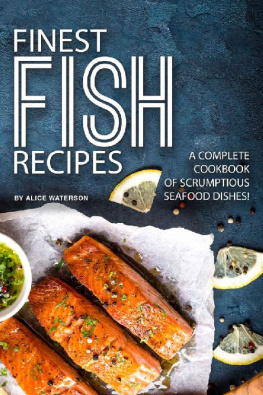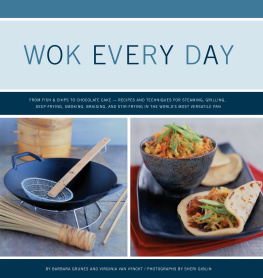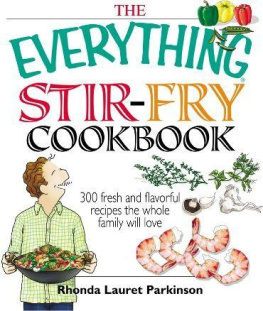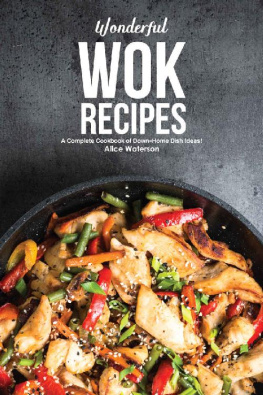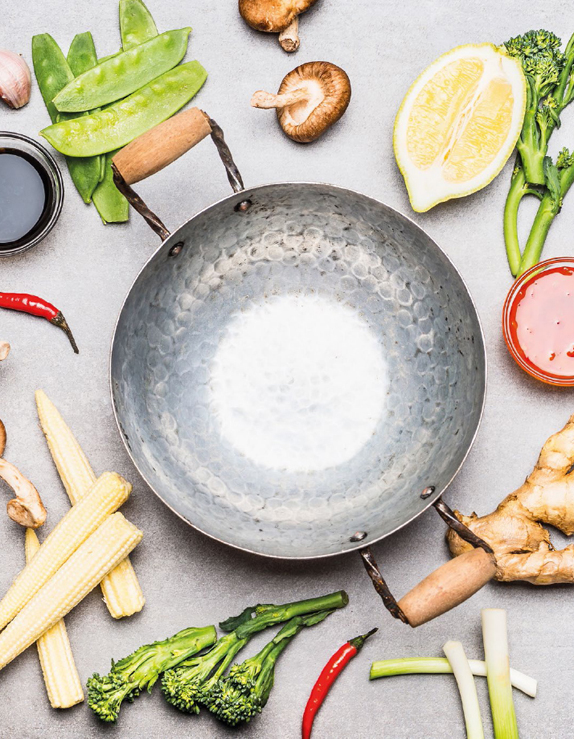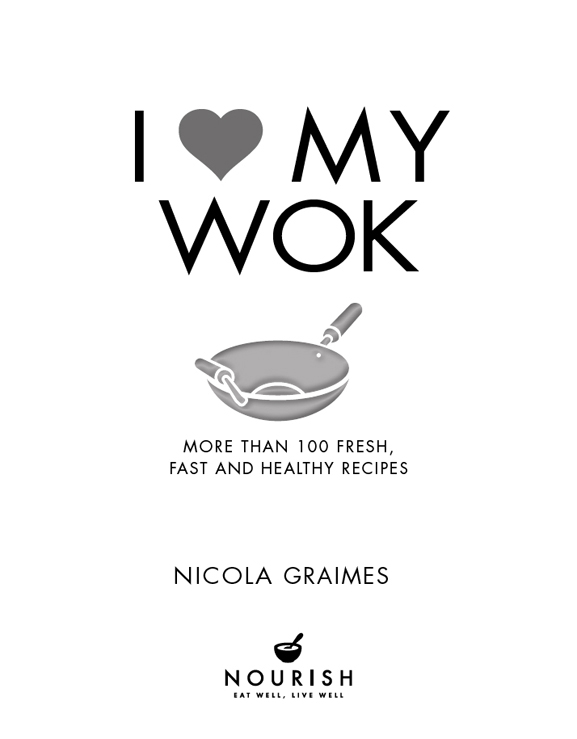CONTENTS
INTRODUCTION
The wok has been an essential piece of equipment in Asian homes for centuries. Yet, despite this ancient lineage, the wok fits perfectly into todays Western-style kitchens and with contemporary styles of cooking.
The great beauty of the wok lies in its simple basic design, which has remained largely unchanged since its conception. While in the Western kitchen its role is often restricted to stir-frying, it is far more versatile. It also makes the ideal tool for steaming, blanching, braising, deep-frying and even for smoking food.
A wok, particularly when it is used for stir-frying, is the key to meals that are not only quick and easy to prepare, but also have the bonus of being healthy. This is largely because the shape of a wok lends itself so well to stir-frying, in which the food cooks rapidly in the minimum amount of oil, helping to keep fat levels down and to retain essential nutrients.
The recipes in this book reflect the true versatility of the wok. They present a huge variety of mouthwatering ways of preparing meat, poultry, fish, vegetables and rice and noodles, as well as soups, dim sum and other appetizers. Inspired by the traditions of some of the worlds great cuisines, most notably those of Far Eastern countries such as China, Japan, Thailand, India, Vietnam and Indonesia, they offer even the most inexperienced cook the route to serving up a feast.
CHOOSING A WOK
Although all woks are basically of the same design, there are a few considerations to make when buying one, such as size, manufacturing material and shape:
If you only intend to buy one wok, choose one that lends itself to a wide range of cooking methods and thats not too small preferably about 3035cm/1214in in diameter. Remember that it is better to have a large wok with a small amount of food in it than vice versa, especially when stir-frying.
A wok will usually have one of two types of handle: a single, long handle or two short, rounded handles on either side. The style you opt for is largely a matter of personal preference, although a single, long handle is generally better for stir-frying, as it distances you from the dangers of any spitting fat, makes it easier for you to toss around the ingredients being cooked and allows you to pick up the wok with one hand. Two-handled models, however, do tend to be more stable, which can be an important attribute when deep-frying or steaming.
Originally, woks were made from cast iron, which retains heat well but makes for a very heavy pan that is difficult to lift. The best modern woks are made from lightweight carbon steel, which is a good heat conductor and is non-stick when seasoned properly (see ). Stainless steel and aluminium woks are lighter still, but tend to scorch and blacken. Non-stick woks may seem like a good idea and are becoming increasingly popular, but bear in mind that they need special care to prevent scratching. Electric woks are convenient, but make sure that you choose the highest wattage possible, since some models do not heat up sufficiently for successful wok cooking.
Shape is another important consideration. Woks come with either a rounded bottom or a flat bottom. A round-bottomed wok is ideal for use on a gas hob, as its shape allows the heat to spread evenly over the surface for rapid cooking, but you will need a wok stand (see ) to hold the wok stable while cooking. Flat-bottomed woks are best for electric hobs or induction cookers, since they allow better direct contact with the heat source and they are independently stable. Whatever shape you opt for, make sure your wok has deep sides, making stir-frying and deep-frying easier and to prevent spillage.
SEASONING A WOK
Your new wok, with the exception of non-stick ones, will need cleaning and seasoning before use. Manufacturers often coat a wok in a protective layer of mineral oil that will need to be removed. To do this:
Scrub the wok well with hot, soapy water, a kitchen cleanser or bicarbonate of soda/baking soda, then dry thoroughly over a low heat.
Now season the wok by pouring in 2 tablespoons of cooking oil and rubbing it all over the inner surface using crumpled paper towels.
Next place the wok over a low heat for 1015 minutes, then wipe the inside again with more paper, held with tongs to avoid burning your fingers.
Repeat the oiling, heating and wiping process until the paper towel comes away clean.
By seasoning your wok in this way regularly, a thin, oily coating will build up on the surface, making it non-stick and preventing rusting. Your wok will also become darker and, with continued use, will begin to impart a highly desirable smoky flavour to food.
LOOKING AFTER YOUR WOK
Once your wok has been seasoned, it should ideally never be cleaned using a detergent; hot water and a cloth or bamboo brush should be all that are necessary to remove any stuck-on food.
After using, leave the wok to cool, then wash it in hot water and dry by placing over a low heat for a minute or two. You can then wipe the inside of the wok with a little cooking oil.
If your wok does rust, or if you find it very difficult to remove burnt-on food, you may need to use some detergent, but you will then have to re-season the wok before you can cook in it again.
COOKS TOOLS
Specialist tools are not essential when cooking with a wok, but certain implements do make the process that much easier.
WOK STAND:
This metal ring is useful if you have a round-bottomed wok, since it makes it more stable on the stove, especially when deep-frying or steaming.
WOK LID:
Not all woks come with a lid, but one is useful and can be bought separately. A light, domed lid is essential for steaming (if you are not using a bamboo steamer) and also prevents sauces, soups and curries from drying out.
RACK:
This metal or wooden trivet can be used when steaming food to raise it above the water line. A rack is also useful when using a wok to smoke foods or for placing cooked food on to keep warm while something else is being cooked.
WOK STIRRER, SCOOP OR PADDLE:
This is indispensable for turning and tossing food when stir-frying. A spade-like implement, it has a slightly curved tip that matches the curve of the inside of the wok, making turning food much easier.
BAMBOO STEAMER:
These are available in a wide range of different sizes. The food is placed in the steamer, which is then placed on top of a wok of simmering water. A number of bamboo steamers can be stacked up on top of each other in order to steam a variety of different foods at the same time. Bamboo steamers come supplied with a lid to prevent the steam escaping.
CHOPSTICKS:
Long, wooden chopsticks are very useful for turning deep-fried foods.
SKIMMER OR LADLE:
A mesh ladle or metal slotted spoon is useful for lifting and draining food that has been stir-fried or deep-fried. Non-perforated ladles are good for adding liquid to a wok.
BAMBOO BRUSH:
This stiff, short brush is useful for cleaning a wok without scratching it or scrubbing off the seasoned surface.
CLEAVER:
This large, flat-bladed, all-purpose knife is perfect for cutting up lots of ingredients quickly and can then be used to scoop up the food and carry it to the wok. The side of a cleaver can also be used to crush garlic or to flatten meat and poultry.

